Attention is all you need
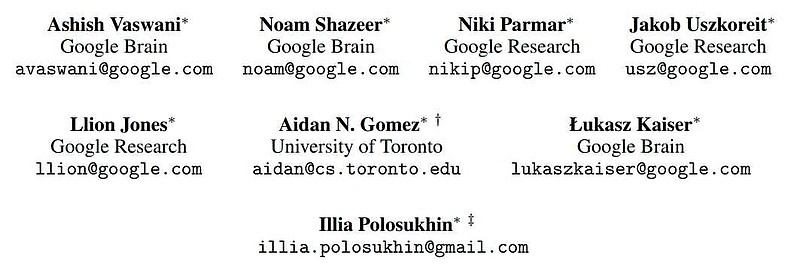
摘要
The dominant sequence transduction models are based on complex recurrent or convolutional neural networks that include an encoder and a decoder. The best performing models also connect the encoder and decoder through an attention mechanism. We propose a new simple network architecture, the Transformer, based solely on attention mechanisms, dispensing with recurrence and convolutions entirely. Experiments on two machine translation tasks show these models to be superior in quality while being more parallelizable and requiring significantly less time to train. Our model achieves 28.4 BLEU on the WMT 2014 English-to-German translation task, improving over the existing best results, including ensembles, by over 2 BLEU. On the WMT 2014 English-to-French translation task, our model establishes a new single-model state-of-the-art BLEU score of 41.8 after training for 3.5 days on eight GPUs, a small fraction of the training costs of the best models from the literature. We show that the Transformer generalizes well to other tasks by applying it successfully to English constituency parsing both with large and limited training data.
主流序列转导模型基于复杂的循环神经网络或卷积神经网络,这些神经网络包含一个编码器和一个解码器。性能最好的模型还通过attention机制将编码器和解码器连接起来。我们提出一种新的简单的网络架构Transformer,仅基于attention机制并完全避免循环和卷积。对两个机器翻译任务的实验表明,这些模型在质量上更加优越、并行性更好并且需要的训练时间显著减少。我们的模型在WMT 2014英语-德语翻译任务上达到28.4 BLEU,超过现有最佳结果(包括整合模型)2个BLEU。在WMT 2014英语-法语翻译任务中,我们的模型建立了单模型新的最先进的BLEU分数41.8,它在8个GPU上训练了3.5天,这个时间只是目前文献中记载的最好的模型训练成本的一小部分。通过在解析大量训练数据和有限训练数据的两种情况下将其应用到English constituency,我们表明Transformer可以很好地推广到其他任务。
1 简介
Recurrent neural networks, long short-term memory [13] and gated recurrent [7] neural networks in particular, have been firmly established as state of the art approaches in sequence modeling and transduction problems such as language modeling and machine translation [35, 2, 5]. Numerous efforts have since continued to push the boundaries of recurrent language models and encoder-decoder architectures [38, 24, 15].
在序列建模和转换问题中,如语言建模和机器翻译[35, 2, 5],循环神经网络特别是长短期记忆[13]和门控循环[7]神经网络,已经被确立为最先进的方法。自那以后,许多努力一直在推动循环语言模型和编码器-解码器架构的界限[38, 24, 15]。
Recurrent models typically factor computation along the symbol positions of the input and output sequences. Aligning the positions to steps in computation time, they generate a sequence of hidden states ht, as a function of the previous hidden state ht-1 and the input for position t. This inherently sequential nature precludes parallelization within training examples, which becomes critical at longer sequence lengths, as memory constraints limit batching across examples. Recent work has achieved significant improvements in computational efficiency through factorization tricks [21] and conditional computation [32], while also improving model performance in case of the latter. The fundamental constraint of sequential computation, however, remains.
循环模型通常是对输入和输出序列的符号位置进行因子计算。通过在计算期间将位置与步骤对齐,它们根据前一步的隐藏状态ht-1和输入产生位置t的隐藏状态序列ht。这种固有的顺序特性阻碍样本训练的并行化,这在更长的序列长度上变得至关重要,因为有限的内存限制样本的批次大小。最近的工作通过巧妙的因子分解[21]和条件计算[32]在计算效率方面取得重大进展,后者还同时提高了模型性能。然而,顺序计算的基本约束依然存在。
Attention mechanisms have become an integral part of compelling sequence modeling and transduction models in various tasks, allowing modeling of dependencies without regard to their distance in the input or output sequences [2, 19]. In all but a few cases [27], however, such attention mechanisms are used in conjunction with a recurrent network.
在各种任务中,attention机制已经成为序列建模和转导模型不可或缺的一部分,它可以建模依赖关系而不考虑其在输入或输出序列中的距离[2, 19]。除少数情况外[27],这种attention机制都与循环网络一起使用。
In this work we propose the Transformer, a model architecture eschewing recurrence and instead relying entirely on an attention mechanism to draw global dependencies between input and output. The Transformer allows for significantly more parallelization and can reach a new state of the art in translation quality after being trained for as little as twelve hours on eight P100 GPUs.
在这项工作中我们提出Transformer,这种模型架构避免循环并完全依赖于attention机制来绘制输入和输出之间的全局依赖关系。Transformer允许进行更多的并行化,并且可以在八个P100 GPU上接受少至十二小时的训练后达到翻译质量的新的最佳结果。
2 背景
The goal of reducing sequential computation also forms the foundation of the Extended Neural GPU [16], ByteNet [18] and ConvS2S [9], all of which use convolutional neural networks as basic building block, computing hidden representations in parallel for all input and output positions. In these models, the number of operations required to relate signals from two arbitrary input or output positions grows in the distance between positions, linearly for ConvS2S and logarithmically for ByteNet. This makes it more difficult to learn dependencies between distant positions [12]. In the Transformer this is reduced to a constant number of operations, albeit at the cost of reduced effective resolution due to averaging attention-weighted positions, an effect we counteract with Multi-Head Attention as described in section 3.2.
减少顺序计算的目标也构成扩展的神经网络GPU [16]、ByteNet [18]和ConvS2S [9]的基础,它们都使用卷积神经网络作为基本构建模块、并行计算所有输入和输出位置的隐藏表示。在这些模型中,关联任意两个输入和输出位置的信号所需的操作次数会随着位置之间的距离而增加,ConvS2S是线性增加,而ByteNet是对数增加。这使得学习远程位置[12]之间的依赖性变得更加困难。在Transformer中,这种操作减少到固定的次数,尽管由于对用attention权重化的位置取平均降低了效果,但是我使用Multi-Head Attention进行抵消,具体描述见 3.2。
Self-attention, sometimes called intra-attention is an attention mechanism relating different positions of a single sequence in order to compute a representation of the sequence. Self-attention has been used successfully in a variety of tasks including reading comprehension, abstractive summarization, textual entailment and learning task-independent sentence representations [4, 27, 28, 22].
Self-attention,有时称为intra-attention,是一种attention机制,它关联单个序列的不同位置以计算序列的表示。Self-attention已成功用于各种任务,包括阅读理解、摘要概括、文本蕴涵和学习与任务无关的句子表征[4, 27, 28, 22]。
End-to-end memory networks are based on a recurrent attention mechanism instead of sequence-aligned recurrence and have been shown to perform well on simple-language question answering and language modeling tasks [34].
端到端的记忆网络基于循环attention机制,而不是序列对齐的循环,并且已被证明在简单语言的问答和语言建模任务中表现良好[34]。
To the best of our knowledge, however, the Transformer is the first transduction model relying entirely on self-attention to compute representations of its input and output without using sequence-aligned RNNs or convolution. In the following sections, we will describe the Transformer, motivate self-attention and discuss its advantages over models such as [17, 18] and [9].
然而,就我们所知,Transformer是第一个完全依靠self-attention来计算输入和输出表示而不使用序列对齐RNN或卷积的转导模型。在下面的章节中,我们将描述Transformer、引出self-attention并讨论它相对[17, 18]和[9]几个模型的优势。
3 模型架构
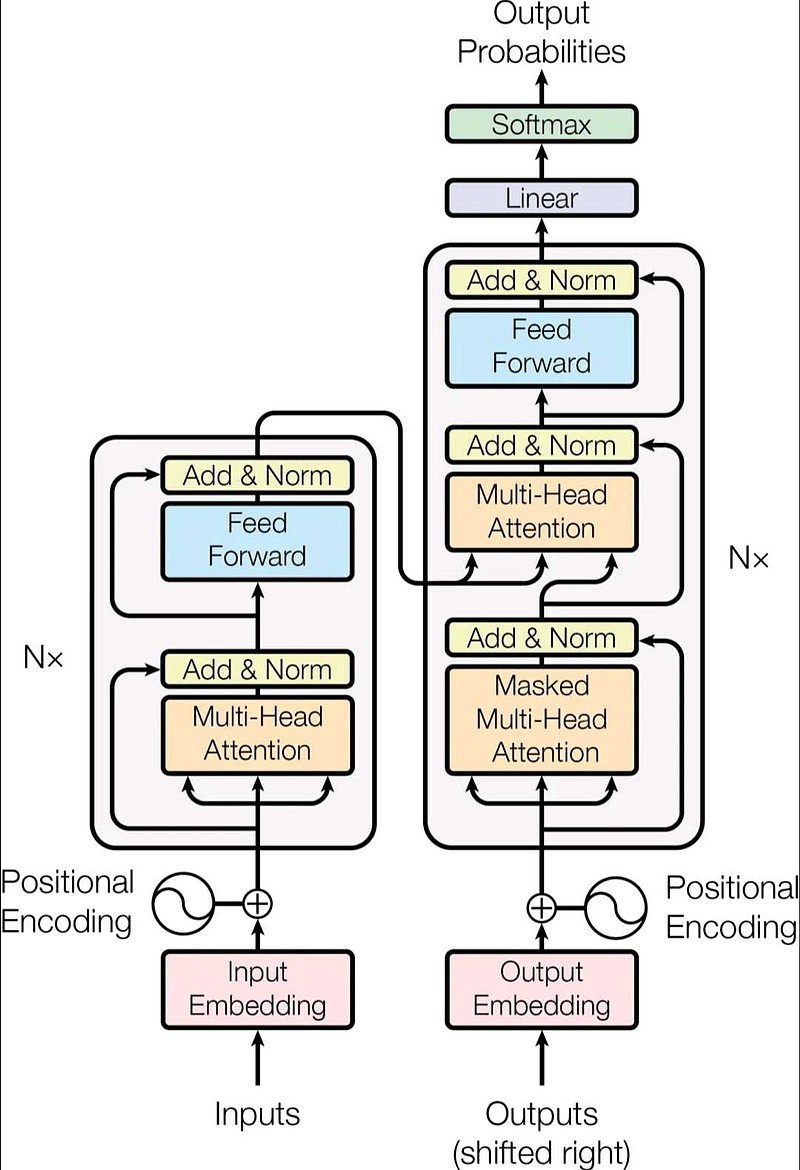
Figure 1: The Transformer - model architecture.
Most competitive neural sequence transduction models have an encoder-decoder structure [5, 2, 35]. Here, the encoder maps an input sequence of symbol representations (x1,...,xn) to a sequence of continuous representations z = (z1,...,zn). Given z, the decoder then generates an output sequence (y1,...,ym) of symbols one element at a time. At each step the model is auto-regressive [10], consuming the previously generated symbols as additional input when generating the next.
大部分神经序列转导模型都有一个编码器-解码器结构[5, 2, 35]。这里,编码器映射一个用符号表示的输入序列 到一个连续的表示。根据,解码器生成符号的一个输出序列 ,一次一个元素。在每一步中,模型都是自回归的[10],当生成下一个时,使用先前生成的符号作为附加输入。
The Transformer follows this overall architecture using stacked self-attention and point-wise, fully connected layers for both the encoder and decoder, shown in the left and right halves of Figure 1, respectively.
Transformer遵循这种整体架构,编码器和解码器都使用self-attention堆叠和point-wise、全连接层,分别显示在图1的左边和右边。
3.1 编码器和解码器堆栈
Encoder: The encoder is composed of a stack of N = 6 identical layers. Each layer has two sub-layers. The first is a multi-head self-attention mechanism, and the second is a simple, position-wise fully connected feed-forward network. We employ a residual connection [11] around each of the two sub-layers, followed by layer normalization [1]. That is, the output of each sub-layer is LayerNorm(x + Sublayer(x)), where Sublayer(x) is the function implemented by the sub-layer itself. To facilitate these residual connections, all sub-layers in the model, as well as the embedding layers, produce outputs of dimension dmodel = 512.
编码器:编码器由N = 6 个完全相同的层堆叠而成。每一层都有两个子层。第一个子层是一个multi-head self-attention机制,第二个子层是一个简单的、位置完全连接的前馈网络。我们对每个子层再采用一个残差连接[11] ,接着进行层标准化[1]。也就是说,每个子层的输出是LayerNorm(x + Sublayer(x)),其中Sublayer(x)是由子层本身实现的函数。为了方便这些残差连接,模型中的所有子层以及嵌入层产生的输出维度都为dmodel = 512。
Decoder: The decoder is also composed of a stack of N = 6 identical layers. In addition to the two sub-layers in each encoder layer, the decoder inserts a third sub-layer, which performs multi-head attention over the output of the encoder stack. Similar to the encoder, we employ residual connections around each of the sub-layers, followed by layer normalization. We also modify the self-attention sub-layer in the decoder stack to prevent positions from attending to subsequent positions. This masking, combined with fact that the output embeddings are offset by one position, ensures that the predictions for position i can depend only on the known outputs at positions less than i.
解码器:解码器同样由N = 6 个完全相同的层堆叠而成。除了每个编码器层中的两个子层之外,解码器还插入第三个子层,该层对编码器堆栈的输出执行multi-head attention。与编码器类似,我们在每个子层再采用残差连接,然后进行层标准化。我们还修改解码器堆栈中的self-attention子层,以防止位置关注到后面的位置。这种掩码结合将输出嵌入偏移一个位置,确保对位置的预测 只能依赖小于 的已知输出。
3.2 注意力机制
An attention function can be described as mapping a query and a set of key-value pairs to an output, where the query, keys, values, and output are all vectors. The output is computed as a weighted sum of the values, where the weight assigned to each value is computed by a compatibility function of the query with the corresponding key.
Attention函数可以描述为将query和一组key-value对映射到输出,其中query、key、value和输出都是向量。输出为value的加权和,其中分配给每个value的权重通过query与相应key的兼容函数来计算。
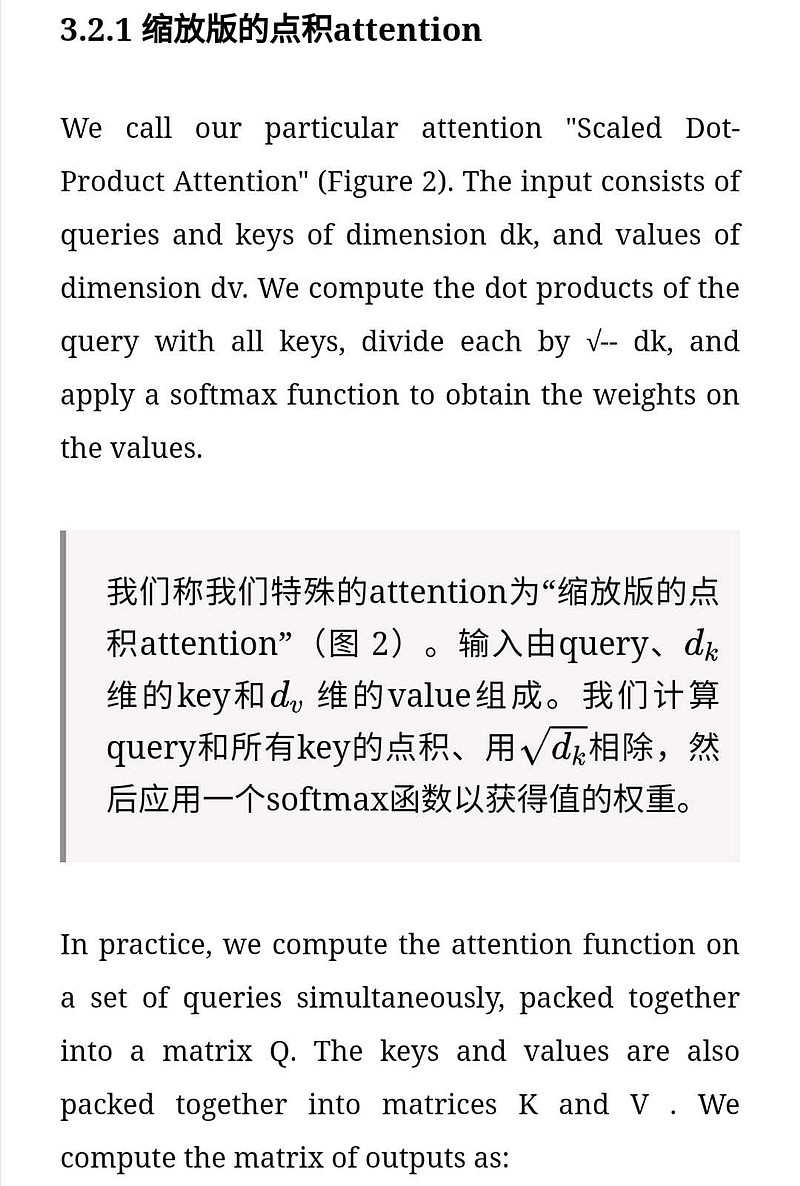
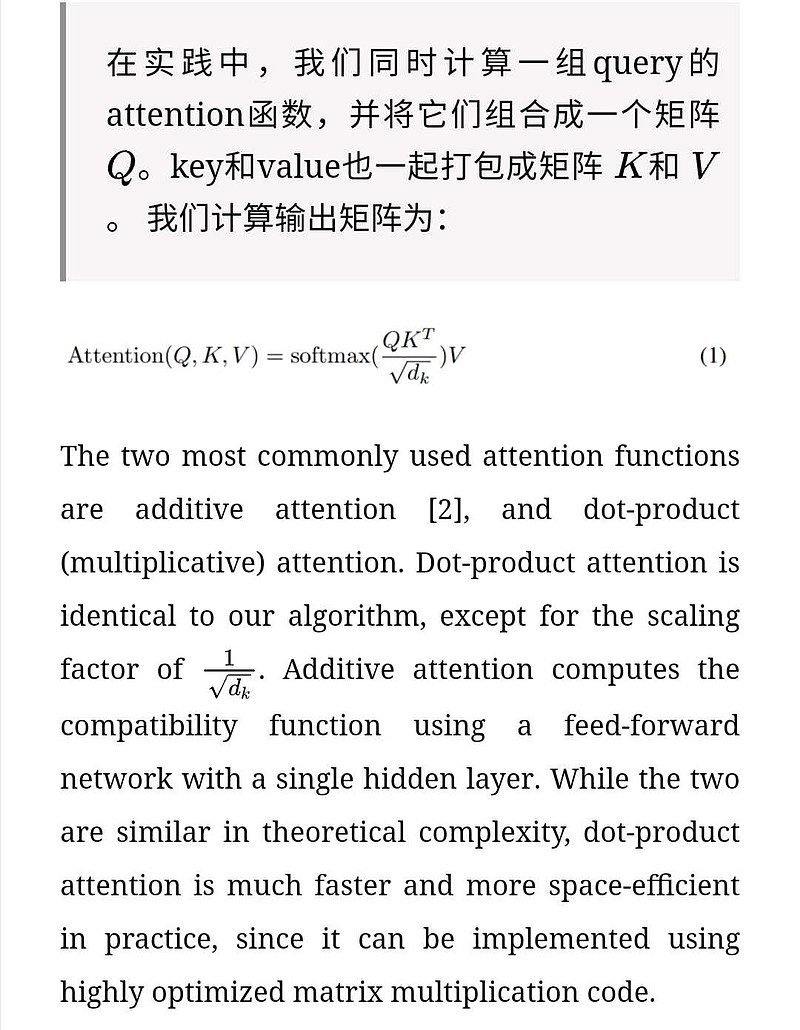
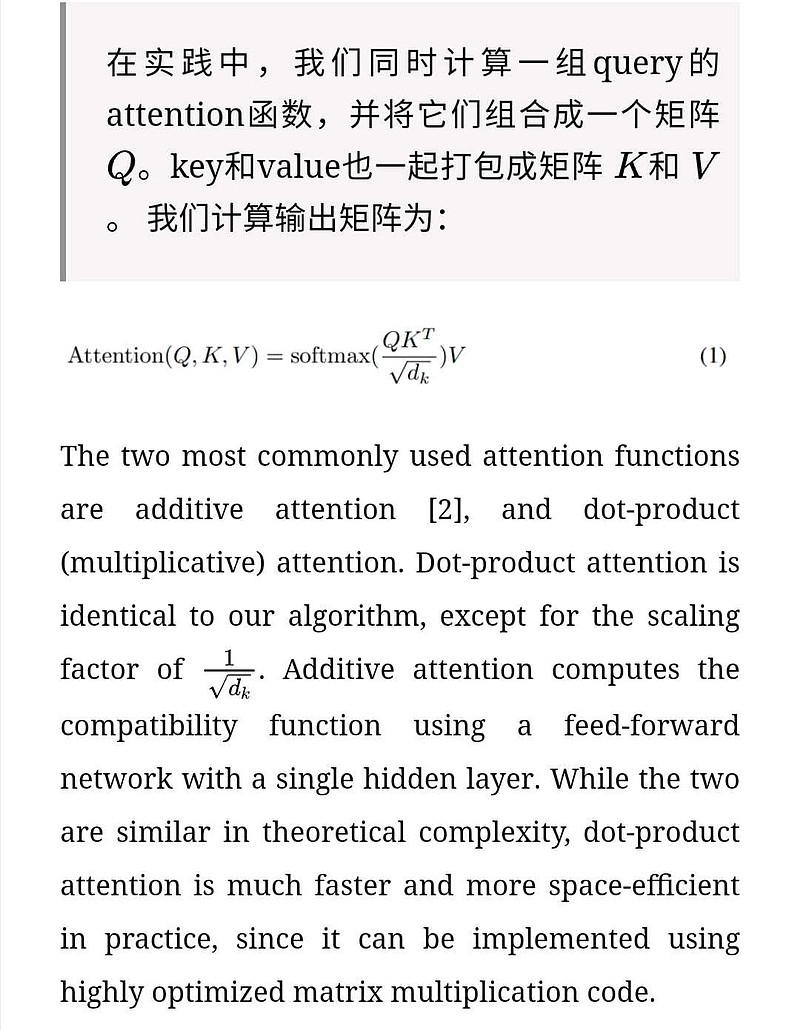
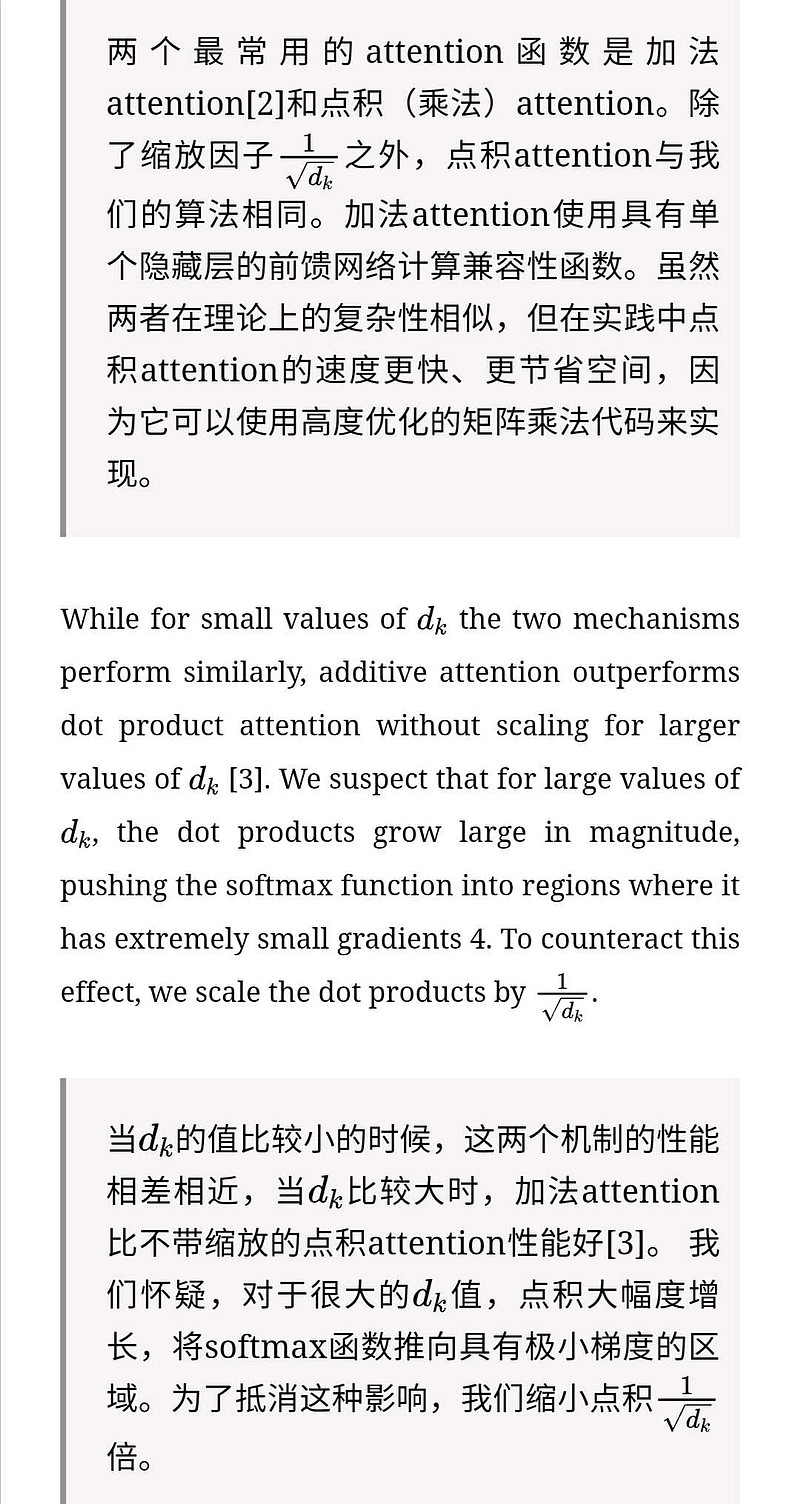
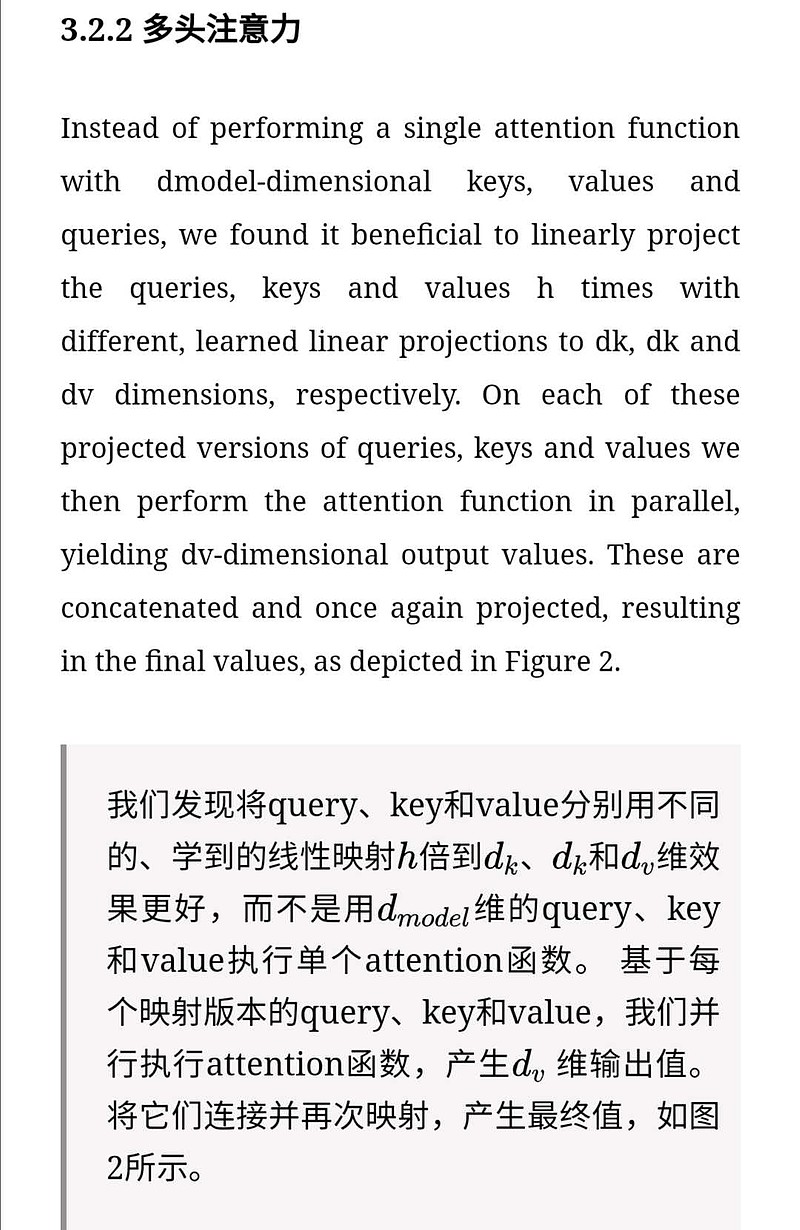
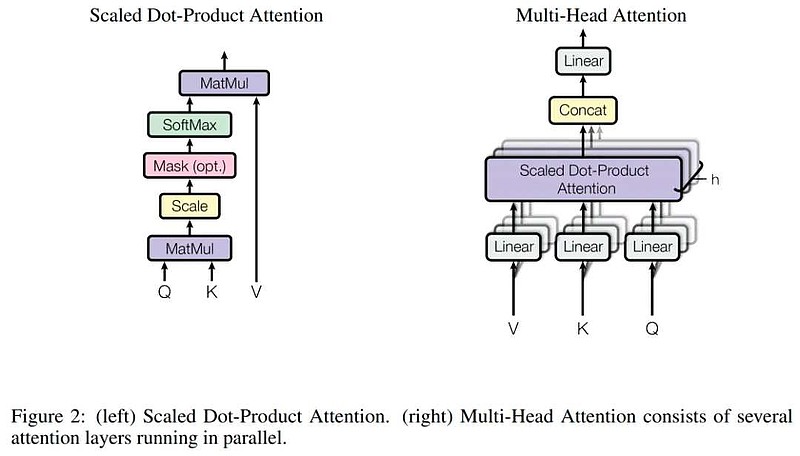
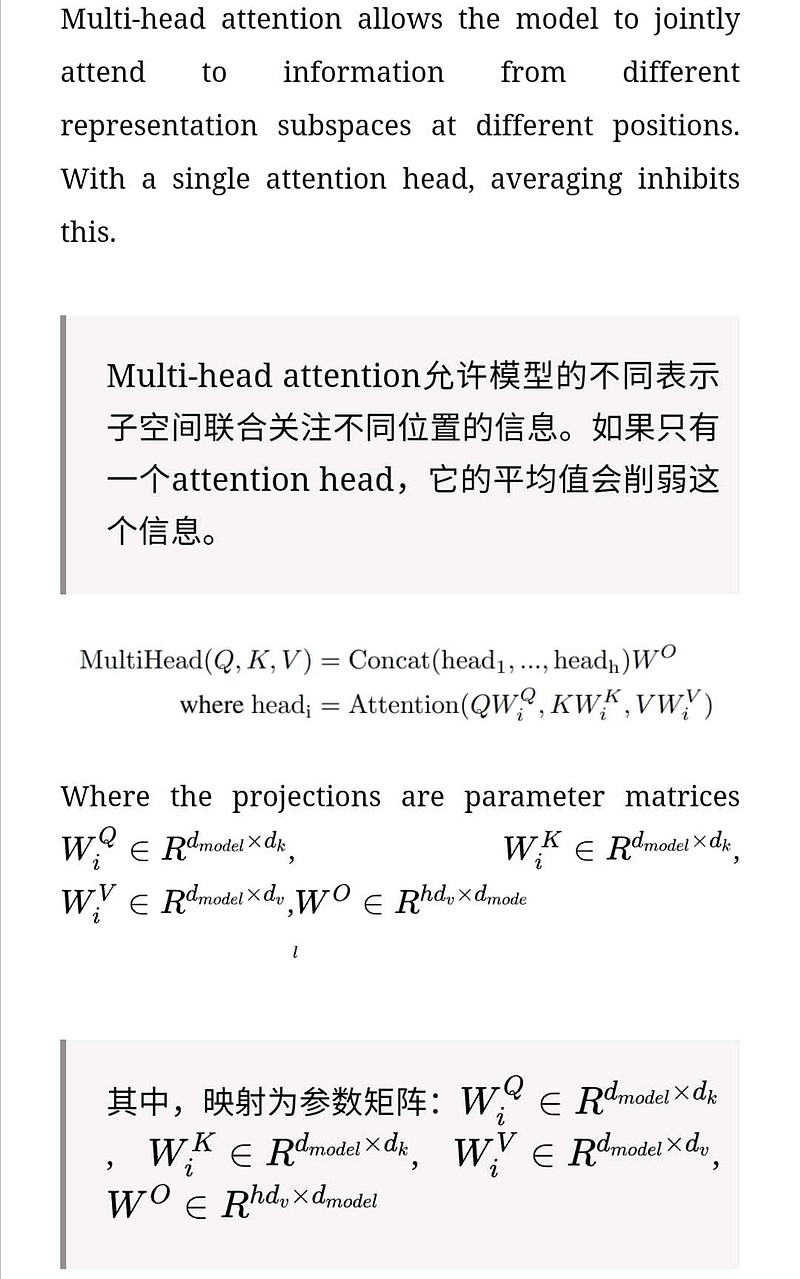
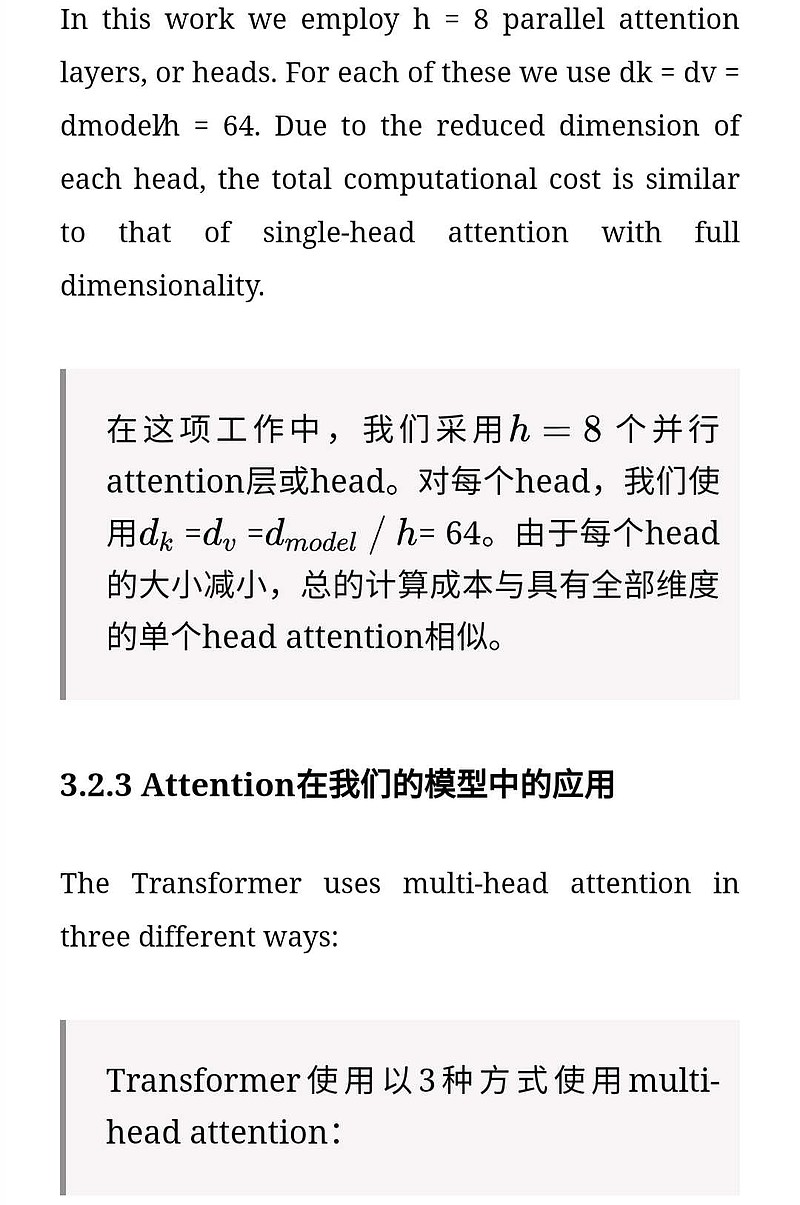
In "encoder-decoder attention" layers, the queries come from the previous decoder layer, and the memory keys and values come from the output of the encoder. This allows every position in the decoder to attend over all positions in the input sequence. This mimics the typical encoder-decoder attention mechanisms in sequence-to-sequence models such as [38, 2, 9].
在“编码器—解码器attention”层,query来自上面的解码器层,key和value来自编码器的输出。这允许解码器中的每个位置能关注到输入序列中的所有位置。这模仿序列到序列模型中典型的编码器—解码器的attention机制,例如[38, 2, 9]。
The encoder contains self-attention layers. In a self-attention layer all of the keys, values and queries come from the same place, in this case, the output of the previous layer in the encoder. Each position in the encoder can attend to all positions in the previous layer of the encoder.
编码器包含self-attention层。在self-attention层中,所有的key、value和query来自同一个地方,在这里是编码器中前一层的输出。编码器中的每个位置都可以关注编码器上一层的所有位置。
Similarly, self-attention layers in the decoder allow each position in the decoder to attend to all positions in the decoder up to and including that position. We need to prevent leftward information flow in the decoder to preserve the auto-regressive property. We implement this inside of scaled dot-product attention by masking out (setting to -∞) all values in the input of the softmax which correspond to illegal connections. See Figure 2.
类似地,解码器中的self-attention层允许解码器中的每个位置都关注解码器中直到并包括该位置的所有位置。我们需要防止解码器中的向左信息流来保持自回归属性。通过屏蔽softmax的输入中所有不合法连接的值(设置为-∞),我们在缩放版的点积attention中实现。见图 2.
3.3 基于位置的前馈网络
In addition to attention sub-layers, each of the layers in our encoder and decoder contains a fully connected feed-forward network, which is applied to each position separately and identically. This consists of two linear transformations with a ReLU activation in between.
除了attention子层之外,我们的编码器和解码器中的每个层都包含一个完全连接的前馈网络,该前馈网络单独且相同地应用于每个位置。它由两个线性变换组成,之间有一个ReLU激活。

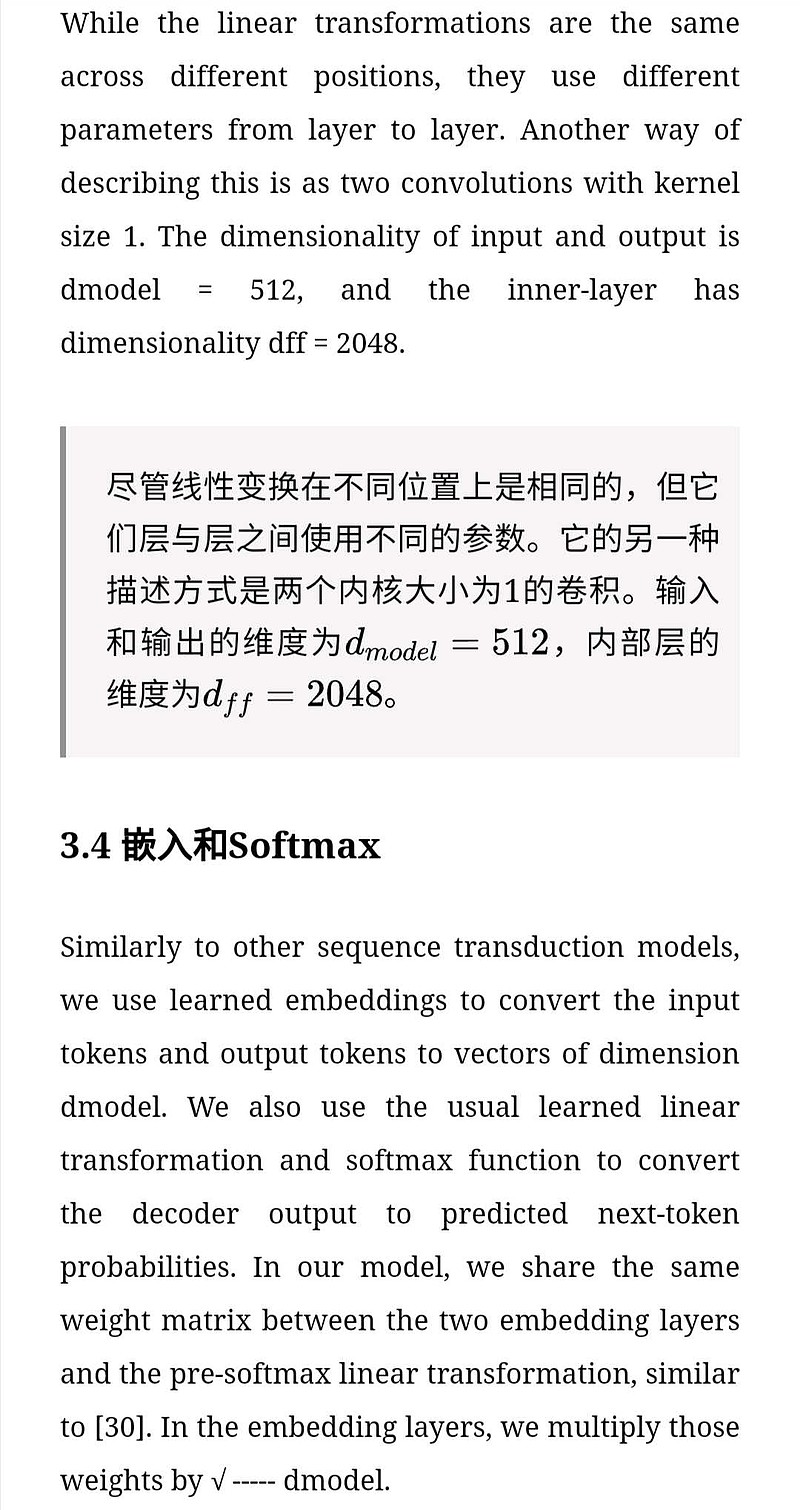
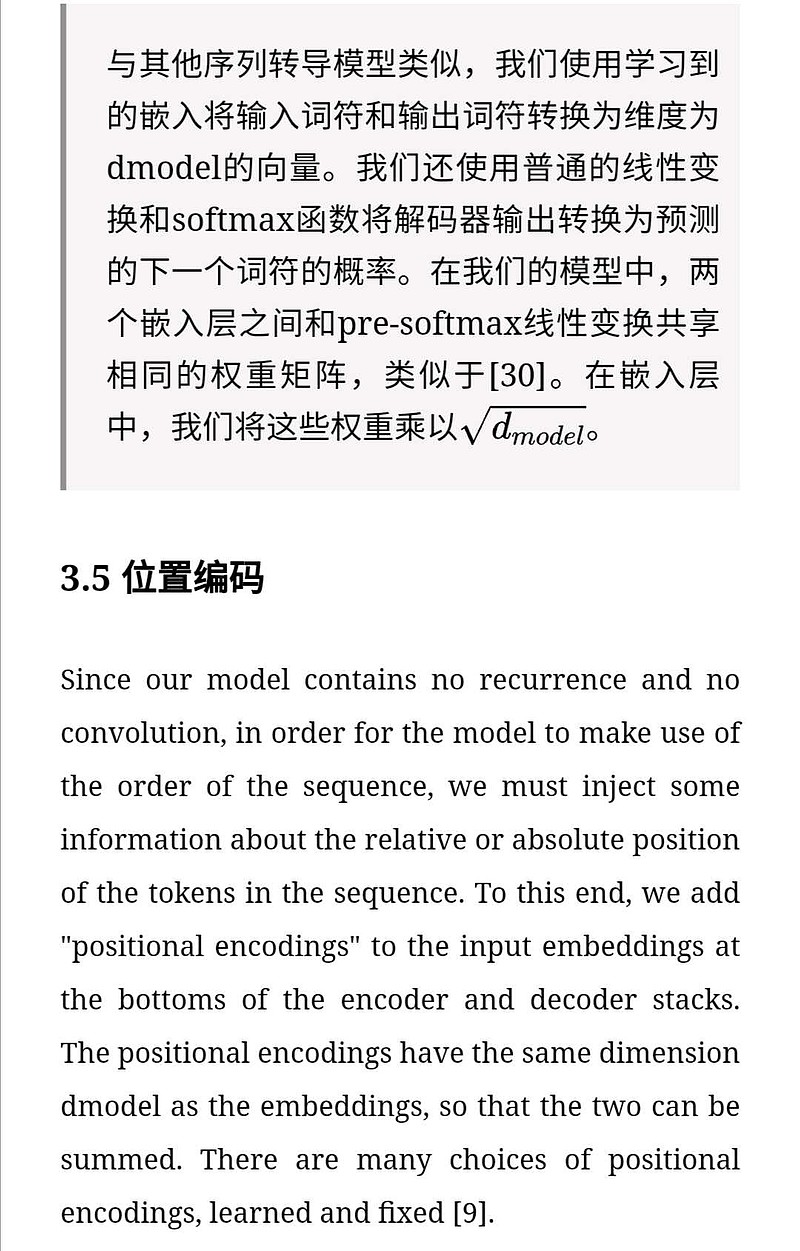
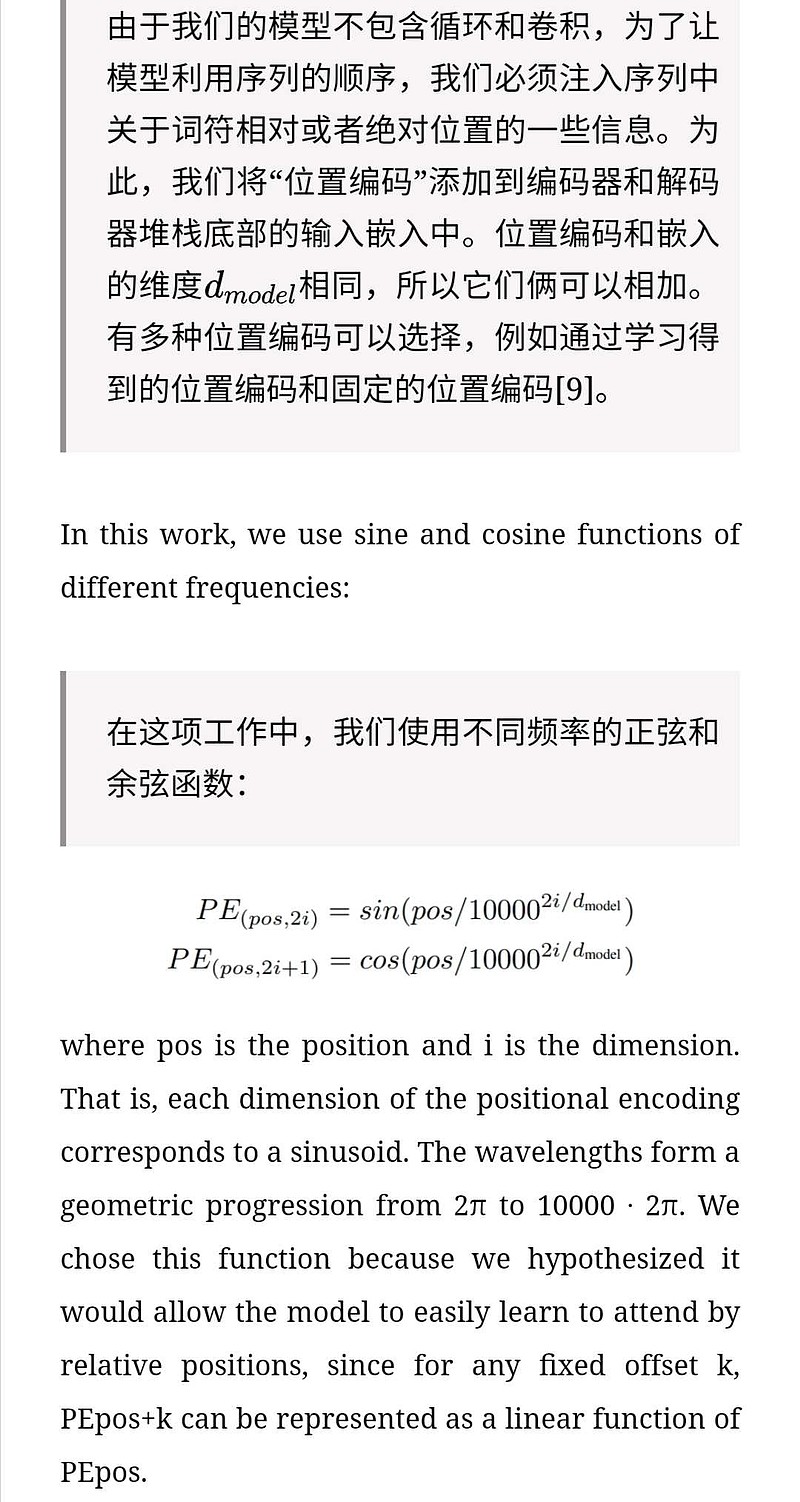
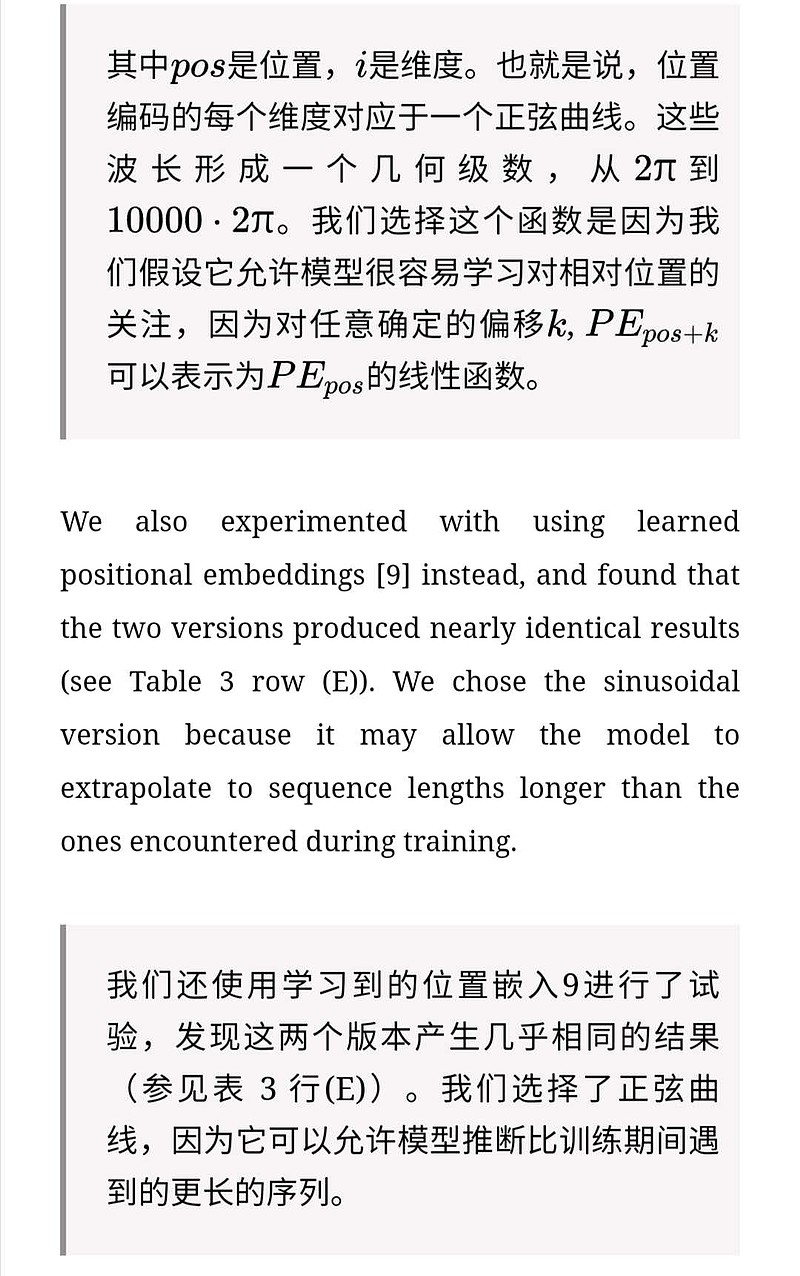
4 为什么选择Self-Attention
In this section we compare various aspects of self-attention layers to the recurrent and convolutional layers commonly used for mapping one variable-length sequence of symbol representations (x1,...,xn) to another sequence of equal length (z1,...,zn), with xi,zi ∈ ℝd, such as a hidden layer in a typical sequence transduction encoder or decoder. Motivating our use of self-attention we consider three desiderata.
本节,我们比较self-attention与循环层和卷积层的各个方面,它们通常用于映射变长的符号序列表示 到另一个等长的序列,其中,例如一个典型的序列转导编码器或解码器中的隐藏层。 我们使用self-attention是考虑到解决三个问题。
One is the total computational complexity per layer. Another is the amount of computation that can be parallelized, as measured by the minimum number of sequential operations required.
一个是每层计算的总复杂度。另一个是可以并行的计算量,以所需的最小顺序操作的数量来衡量。
The third is the path length between long-range dependencies in the network. Learning long-range dependencies is a key challenge in many sequence transduction tasks. One key factor affecting the ability to learn such dependencies is the length of the paths forward and backward signals have to traverse in the network. The shorter these paths between any combination of positions in the input and output sequences, the easier it is to learn long-range dependencies [12]. Hence we also compare the maximum path length between any two input and output positions in networks composed of the different layer types.
第三个是网络中长距离依赖之间的路径长度。学习长距离依赖性是许多序列转导任务中的关键挑战。影响学习这种依赖性能力的一个关键因素是前向和后向信号必须在网络中传播的路径长度。输入和输出序列中任意位置组合之间的这些路径越短,学习远距离依赖性就越容易[12]。因此,我们还比较了由不同图层类型组成的网络中任意两个输入和输出位置之间的最大路径长度。
表1:不同图层类型的最大路径长度、每层复杂度和最少顺序操作数。n 为序列的长度,d 为表示的维度,k 为卷积的核的大小,r 为受限self-attention中邻域的大小。

As noted in Table 1, a self-attention layer connects all positions with a constant number of sequentially executed operations, whereas a recurrent layer requires O(n) sequential operations. In terms of computational complexity, self-attention layers are faster than recurrent layers when the sequence length n is smaller than the representation dimensionality d, which is most often the case with sentence representations used by state-of-the-art models in machine translations, such as word-piece [38] and byte-pair [31] representations. To improve computational performance for tasks involving very long sequences, self-attention could be restricted to considering only a neighborhood of size r in the input sequence centered around the respective output position. This would increase the maximum path length to O(n/r). We plan to investigate this approach further in future work.
如表1所示,self-attention层将所有位置连接到恒定数量的顺序执行的操作,而循环层需要O(n)顺序操作。在计算复杂性方面,当序列长度n小于表示维度d时,self-attention层比循环层快,这是机器翻译中最先进的模型最常见情况,例如单词[38]表示法和字节对[31]表示法。为了提高涉及很长序列的任务的计算性能,可以将self-attention限制在仅考虑大小为的邻域。这会将最大路径长度增加到O(n/r)。我们计划在未来的工作中进一步调查这种方法。
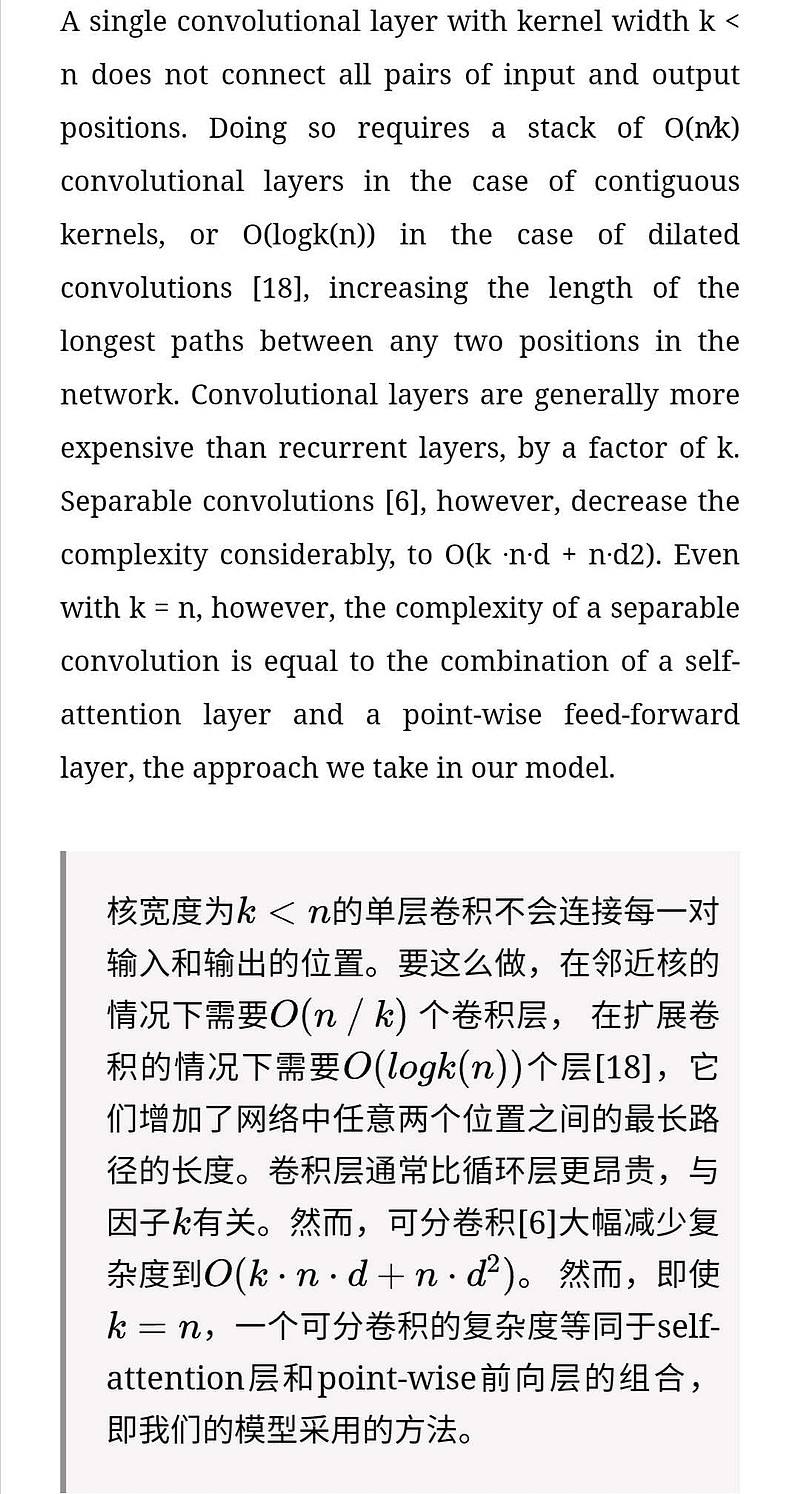
As side benefit, self-attention could yield more interpretable models. We inspect attention distributions from our models and present and discuss examples in the appendix. Not only do individual attention heads clearly learn to perform different tasks, many appear to exhibit behavior related to the syntactic and semantic structure of the sentences.
间接的好处是self-attention可以产生更可解释的模型。我们从我们的模型中研究attention的分布,并在附录中展示和讨论示例。每个attention head不仅清楚地学习到执行不同的任务,许多似乎展现与句子的句法和语义结构的行为。
5 训练
This section describes the training regime for our models.
本节介绍我们的模型训练方法。
5.1 训练数据和批次
We trained on the standard WMT 2014 English-German dataset consisting of about 4.5 million sentence pairs. Sentences were encoded using byte-pair encoding [3], which has a shared source-target vocabulary of about 37000 tokens. For English-French, we used the significantly larger WMT 2014 English-French dataset consisting of 36M sentences and split tokens into a 32000 word-piece vocabulary [38]. Sentence pairs were batched together by approximate sequence length. Each training batch contained a set of sentence pairs containing approximately 25000 source tokens and 25000 target tokens.
我们在标准的WMT 2014英语-德语数据集上进行了训练,其中包含约450万个句子对。这些句子使用字节对编码[3]进行编码,源语句和目标语句共享大约37000个词符的词汇表。对于英语-法语翻译,我们使用大得多的WMT 2014英法数据集,它包含3600万个句子,并将词符分成32000个word-piece词汇表[38]。序列长度相近的句子一起进行批处理。每个训练批次的句子对包含大约25000个源词符和25000个目标词符。
5.2 硬件和时间
We trained our models on one machine with 8 NVIDIA P100 GPUs. For our base models using the hyperparameters described throughout the paper, each training step took about 0.4 seconds. We trained the base models for a total of 100,000 steps or 12 hours. For our big models,(described on the bottom line of table 3), step time was 1.0 seconds. The big models were trained for 300,000 steps (3.5 days).
我们在一台具有8个NVIDIA P100 GPU的机器上训练我们的模型。使用本文描述的超参数的基础模型,每个训练步骤耗时约0.4秒。我们的基础模型共训练了10万步或12小时。For our big models,(described on the bottom line of table 3), step time was 1.0 seconds. 大模型训练了30万步(3.5天)。
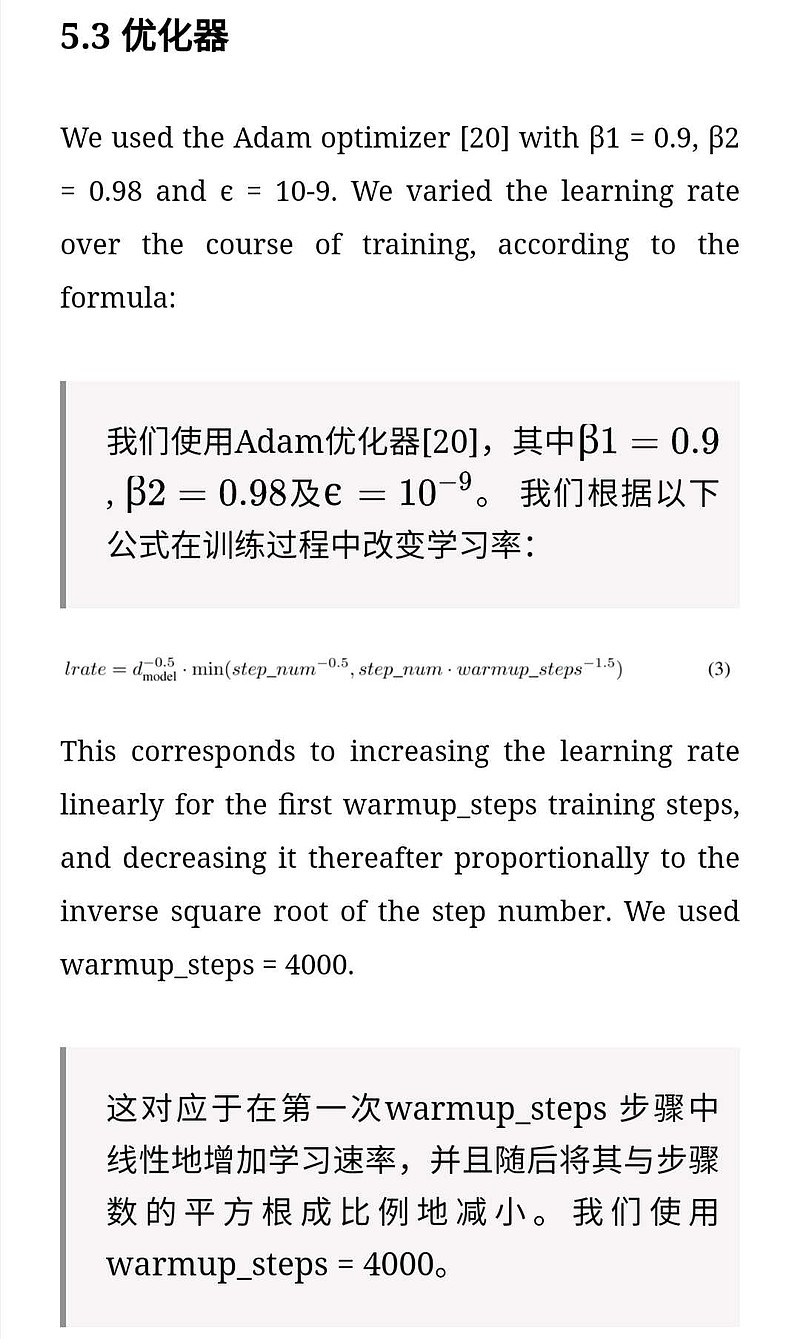
5.4 正则化
We employ three types of regularization during training:
训练期间我们采用三种正则化:
Residual Dropout We apply dropout [33] to the output of each sub-layer, before it is added to the sub-layer input and normalized. In addition, we apply dropout to the sums of the embeddings and the positional encodings in both the encoder and decoder stacks. For the base model, we use a rate of Pdrop = 0.1.
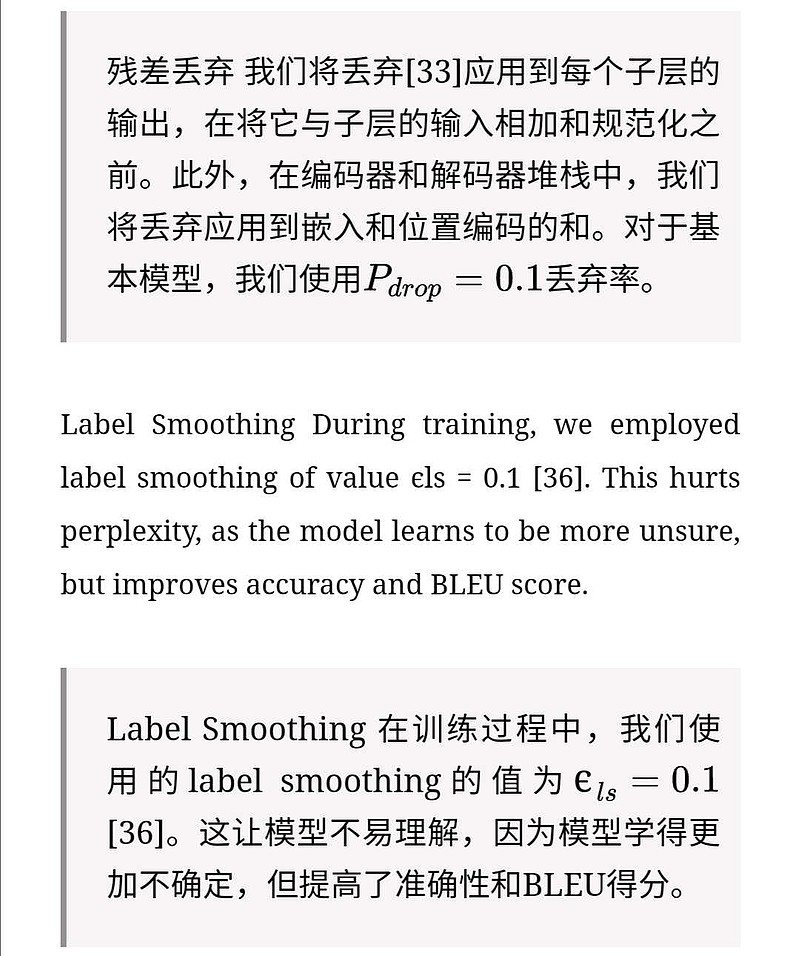
6 结果
6.1 机器翻译
On the WMT 2014 English-to-German translation task, the big transformer model (Transformer (big) in Table 2) outperforms the best previously reported models (including ensembles) by more than 2.0 BLEU, establishing a new state-of-the-art BLEU score of 28.4. The configuration of this model is listed in the bottom line of Table 3. Training took 3.5 days on 8 P100 GPUs. Even our base model surpasses all previously published models and ensembles, at a fraction of the training cost of any of the competitive models.
在WMT 2014英语-德语翻译任务中,大型transformer模型(表2中的Transformer (big))比以前报道的最佳模型(包括整合模型)高出2.0 个BLEU以上,确立了一个全新的最高BLEU分数为28.4。该模型的配置列在表3的底部。训练在8 个P100 GPU上花费3.5 天。即使我们的基础模型也超过了以前发布的所有模型和整合模型,且训练成本只是这些模型的一小部分。
表2:Transformer在英语-德语和英语-法语newstest2014测试中获得的BLEU分数比以前的最新模型的分数更好,且训练成本只是它们的一小部分。
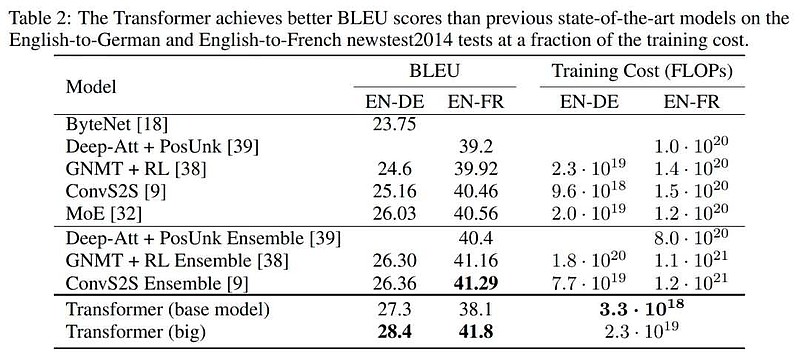
On the WMT 2014 English-to-French translation task, our big model achieves a BLEU score of 41.0, outperforming all of the previously published single models, at less than 1∕4 the training cost of the previous state-of-the-art model. The Transformer (big) model trained for English-to-French used dropout rate Pdrop = 0.1, instead of 0.3.
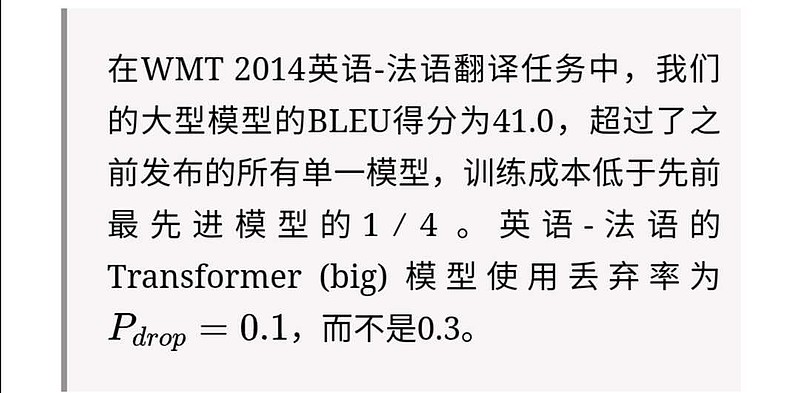
For the base models, we used a single model obtained by averaging the last 5 checkpoints, which were written at 10-minute intervals. For the big models, we averaged the last 20 checkpoints. We used beam search with a beam size of 4 and length penalty α = 0.6 [38]. These hyperparameters were chosen after experimentation on the development set. We set the maximum output length during inference to input length + 50, but terminate early when possible [38].
对于基础模型,我们使用的单个模型来自最后5个检查点的平均值,这些检查点每10分钟写一次。对于大型模型,我们对最后20个检查点进行了平均。我们使用beam search,beam大小为4 ,长度惩罚α = 0.6 [38]。 这些超参数是在开发集上进行实验后选定的。在推断时,我们设置最大输出长度为输入长度+50,但在可能时尽早终止[38]。
Table 2 summarizes our results and compares our translation quality and training costs to other model architectures from the literature. We estimate the number of floating point operations used to train a model by multiplying the training time, the number of GPUs used, and an estimate of the sustained single-precision floating-point capacity of each GPU 5.
表2总结了我们的结果,并将我们的翻译质量和训练成本与文献中的其他模型体系结构进行了比较。我们通过将训练时间、所使用的GPU的数量以及每个GPU的持续单精度浮点能力的估计相乘来估计用于训练模型的浮点运算的数量5。
6.2 模型的变体
To evaluate the importance of different components of the Transformer, we varied our base model in different ways, measuring the change in performance on English-to-German translation on the development set, newstest2013. We used beam search as described in the previous section, but no checkpoint averaging. We present these results in Table 3.
为了评估Transformer不同组件的重要性,我们以不同的方式改变我们的基础模型,测量开发集newstest2013上英文-德文翻译的性能变化。我们使用前一节所述的beam搜索,但没有平均检查点。我们在表中列出这些结果 3.
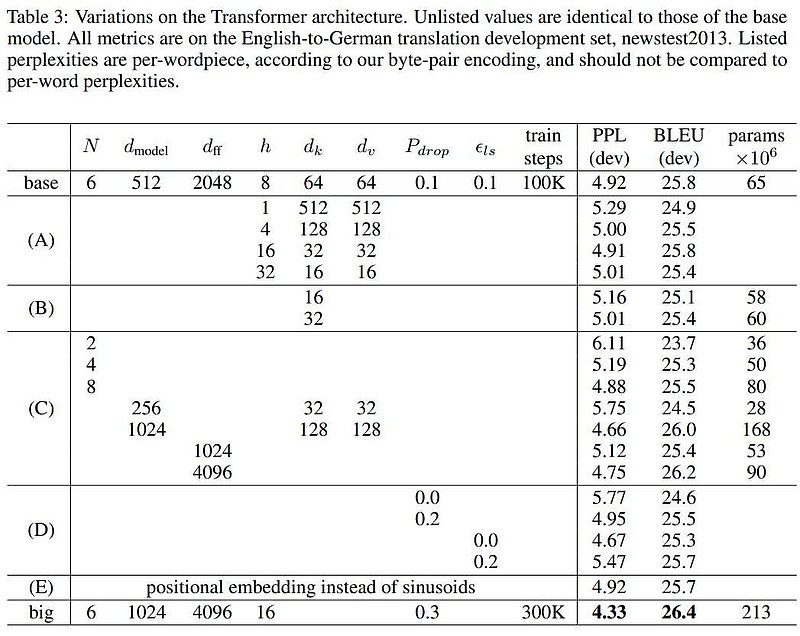
In Table 3 rows (A), we vary the number of attention heads and the attention key and value dimensions, keeping the amount of computation constant, as described in Section 3.2.2. While single-head attention is 0.9 BLEU worse than the best setting, quality also drops off with too many heads.
在表3的行(A)中,我们改变attention head的数量和attention key和value的维度,保持计算量不变,如3.2.2节所述。虽然只有一个head attention比最佳设置差0.9 BLEU,但质量也随着head太多而下降。
In Table 3 rows (B), we observe that reducing the attention key size dk hurts model quality. This suggests that determining compatibility is not easy and that a more sophisticated compatibility function than dot product may be beneficial. We further observe in rows (C) and (D) that, as expected, bigger models are better, and dropout is very helpful in avoiding over-fitting. In row (E) we replace our sinusoidal positional encoding with learned positional embeddings [9], and observe nearly identical results to the base model.
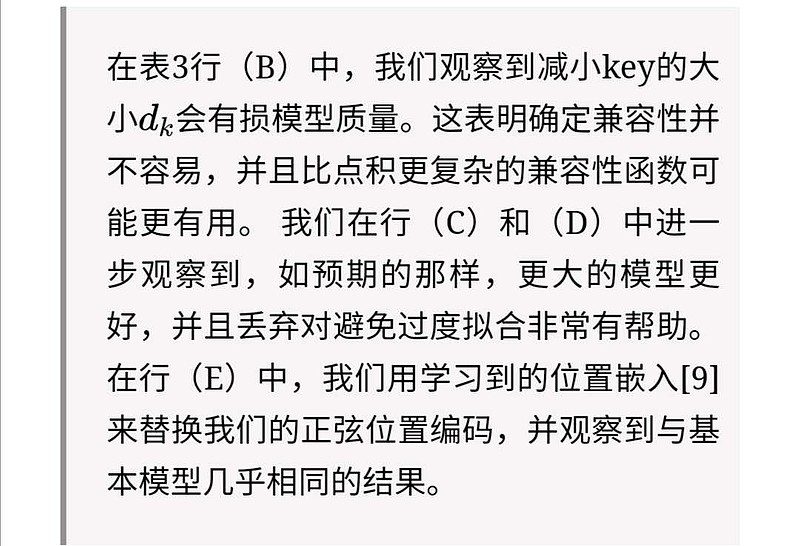
To evaluate if the Transformer can generalize to other tasks we performed experiments on English constituency parsing. This task presents specific challenges: the output is subject to strong structural constraints and is significantly longer than the input. Furthermore, RNN sequence-to-sequence models have not been able to attain state-of-the-art results in small-data regimes [37].
为了评估这个Transformer是否可以推广到其他任务,我们进行了英语句法分析实验。这项任务提出特别的挑战:输出受到很强的结构性约束,并且比输入要长很多。此外,RNN序列到序列模型还没有能够在小数据[37]中获得最好的结果。
We trained a 4-layer transformer with dmodel = 1024 on the Wall Street Journal (WSJ) portion of the Penn Treebank [25], about 40K training sentences. We also trained it in a semi-supervised setting, using the larger high-confidence and BerkleyParser corpora from with approximately 17M sentences [37]. We used a vocabulary of 16K tokens for the WSJ only setting and a vocabulary of 32K tokens for the semi-supervised setting.
我们用dmodel = 1024 在Penn Treebank[25]的Wall Street Journal(WSJ)部分训练了一个4层transformer,约40K个训练句子。我们还使用更大的高置信度和BerkleyParser语料库,在半监督环境中对其进行了训练,大约17M个句子[37]。我们使用了一个16K词符的词汇表作为WSJ唯一设置,和一个32K词符的词汇表用于半监督设置。
We performed only a small number of experiments to select the dropout, both attention and residual (section 5.4), learning rates and beam size on the Section 22 development set, all other parameters remained unchanged from the English-to-German base translation model. During inference, we increased the maximum output length to input length + 300. We used a beam size of 21 and α = 0.3 for both WSJ only and the semi-supervised setting.
我们只做了少量的实验来选择dropout,注意力机制和残差(第5.4节),学习率和波束大小在第22节开发集,所有其他参数在英德语基础翻译模型中保持不变。在推断过程中,我们将最大输出长度增加到输入长度+300。对于WSJ和半监督设置,我们都使用beam大小21 和α = 0.3 。
Our results in Table 4 show that despite the lack of task-specific tuning our model performs surprisingly well, yielding better results than all previously reported models with the exception of the Recurrent Neural Network Grammar [8].
表4中我们的结果表明,尽管缺少特定任务的调优,我们的模型表现得非常好,得到的结果比之前报告的除循环神经网络语法[8]之外的所有模型都好。
In contrast to RNN sequence-to-sequence models [37], the Transformer outperforms the BerkeleyParser [29] even when training only on the WSJ training set of 40K sentences.
与RNN序列到序列模型[37]相比,即使仅在WSJ训练40K句子组训练时,Transformer也胜过BerkeleyParser [29]。
7 结论
In this work, we presented the Transformer, the first sequence transduction model based entirely on attention, replacing the recurrent layers most commonly used in encoder-decoder architectures with multi-headed self-attention.
在这项工作中,我们提出了Transformer,第一个完全基于注意力的序列转导模型,用multi-headed self-attention取代了编码器-解码器架构中最常用的循环层。
For translation tasks, the Transformer can be trained significantly faster than architectures based on recurrent or convolutional layers. On both WMT 2014 English-to-German and WMT 2014 English-to-French translation tasks, we achieve a new state of the art. In the former task our best model outperforms even all previously reported ensembles.
对于翻译任务,Transformer可以比基于循环或卷积层的体系结构训练更快。在WMT 2014英语-德语和WMT 2014英语-法语翻译任务中,我们取得了最好的结果。在前面的任务中,我们最好的模型甚至胜过以前报道过的所有整合模型。
We are excited about the future of attention-based models and plan to apply them to other tasks. We plan to extend the Transformer to problems involving input and output modalities other than text and to investigate local, restricted attention mechanisms to efficiently handle large inputs and outputs such as images, audio and video. Making generation less sequential is another research goals of ours.
我们对基于attention的模型的未来感到兴奋,并计划将它们应用于其他任务。我们计划将Transformer扩展到除文本之外的涉及输入和输出模式的问题,并调查局部的、受限attention机制以有效处理大型输入和输出,如图像、音频和视频。让生成具有更少的顺序性是我们的另一个研究目标。
The code we used to train and evaluate our models is available at 网页链接
我们用于训练和评估模型的代码可以在网页链接上找到。
致谢
We are grateful to Nal Kalchbrenner and Stephan Gouws for their fruitful comments, corrections and inspiration.
我们感谢Nal Kalchbrenner和Stephan Gouws富有成效的评论、更正和灵感。
参考文献
[1] Jimmy Lei Ba, Jamie Ryan Kiros, and Geoffrey E Hinton. Layer normalization. arXiv preprint arXiv:1607.06450, 2016.
[2] Dzmitry Bahdanau, Kyunghyun Cho, and Yoshua Bengio. Neural machine translation by jointly learning to align and translate. CoRR, abs/1409.0473, 2014.
[3] Denny Britz, Anna Goldie, Minh-Thang Luong, and Quoc V. Le. Massive exploration of neural machine translation architectures. CoRR, abs/1703.03906, 2017.
[4] Jianpeng Cheng, Li Dong, and Mirella Lapata. Long short-term memory-networks for machine reading. arXiv preprint arXiv:1601.06733, 2016.
[5] Kyunghyun Cho, Bart van Merrienboer, Caglar Gulcehre, Fethi Bougares, Holger Schwenk, and Yoshua Bengio. Learning phrase representations using rnn encoder-decoder for statistical machine translation. CoRR, abs/1406.1078, 2014.
[6] Francois Chollet. Xception: Deep learning with depthwise separable convolutions. arXiv preprint arXiv:1610.02357, 2016.
[7] Junyoung Chung, Çaglar Gülçehre, Kyunghyun Cho, and Yoshua Bengio. Empirical evaluation of gated recurrent neural networks on sequence modeling. CoRR, abs/1412.3555, 2014.
[8] Chris Dyer, Adhiguna Kuncoro, Miguel Ballesteros, and Noah A. Smith. Recurrent neural network grammars. In Proc. of NAACL, 2016.
[9] Jonas Gehring, Michael Auli, David Grangier, Denis Yarats, and Yann N. Dauphin. Convolutional sequence to sequence learning. arXiv preprint arXiv:1705.03122v2, 2017.
[10] Alex Graves. Generating sequences with recurrent neural networks. arXiv preprint arXiv:1308.0850, 2013.
[11] Kaiming He, Xiangyu Zhang, Shaoqing Ren, and Jian Sun. Deep residual learning for image recognition. In Proceedings of the IEEE Conference on Computer Vision and Pattern Recognition, pages 770–778, 2016.
[12] Sepp Hochreiter, Yoshua Bengio, Paolo Frasconi, and Jürgen Schmidhuber. Gradient flow in recurrent nets: the difficulty of learning long-term dependencies, 2001.
[13] Sepp Hochreiter and Jürgen Schmidhuber. Long short-term memory. Neural computation, 9(8):1735–1780, 1997.
[14] Zhongqiang Huang and Mary Harper. Self-training PCFG grammars with latent annotations across languages. In Proceedings of the 2009 Conference on Empirical Methods in Natural Language Processing, pages 832–841. ACL, August 2009.
[15] Rafal Jozefowicz, Oriol Vinyals, Mike Schuster, Noam Shazeer, and Yonghui Wu. Exploring the limits of language modeling. arXiv preprint arXiv:1602.02410, 2016.
[16] Łukasz Kaiser and Samy Bengio. Can active memory replace attention? In Advances in Neural Information Processing Systems, (NIPS), 2016.
[17] Łukasz Kaiser and Ilya Sutskever. Neural GPUs learn algorithms. In International Conference on Learning Representations (ICLR), 2016.
[18] Nal Kalchbrenner, Lasse Espeholt, Karen Simonyan, Aaron van den Oord, Alex Graves, and Koray Kavukcuoglu. Neural machine translation in linear time. arXiv preprint arXiv:1610.10099v2, 2017.
[19] Yoon Kim, Carl Denton, Luong Hoang, and Alexander M. Rush. Structured attention networks. In International Conference on Learning Representations, 2017.
[20] Diederik Kingma and Jimmy Ba. Adam: A method for stochastic optimization. In ICLR, 2015.
[21] Oleksii Kuchaiev and Boris Ginsburg. Factorization tricks for LSTM networks. arXiv preprint arXiv:1703.10722, 2017.
[22] Zhouhan Lin, Minwei Feng, Cicero Nogueira dos Santos, Mo Yu, Bing Xiang, Bowen Zhou, and Yoshua Bengio. A structured self-attentive sentence embedding. arXiv preprint arXiv:1703.03130, 2017.
[23] Minh-Thang Luong, Quoc V. Le, Ilya Sutskever, Oriol Vinyals, and Lukasz Kaiser. Multi-task sequence to sequence learning. arXiv preprint arXiv:1511.06114, 2015.
[24] Minh-Thang Luong, Hieu Pham, and Christopher D Manning. Effective approaches to attention-based neural machine translation. arXiv preprint arXiv:1508.04025, 2015.
[25] Mitchell P Marcus, Mary Ann Marcinkiewicz, and Beatrice Santorini. Building a large annotated corpus of english: The penn treebank. Computational linguistics, 19(2):313–330, 1993.
[26] David McClosky, Eugene Charniak, and Mark Johnson. Effective self-training for parsing. In Proceedings of the Human Language Technology Conference of the NAACL, Main Conference, pages 152–159. ACL, June 2006.
[27] Ankur Parikh, Oscar Täckström, Dipanjan Das, and Jakob Uszkoreit. A decomposable attention model. In Empirical Methods in Natural Language Processing, 2016.
[28] Romain Paulus, Caiming Xiong, and Richard Socher. A deep reinforced model for abstractive summarization. arXiv preprint arXiv:1705.04304, 2017.
[29] Slav Petrov, Leon Barrett, Romain Thibaux, and Dan Klein. Learning accurate, compact, and interpretable tree annotation. In Proceedings of the 21st International Conference on Computational Linguistics and 44th Annual Meeting of the ACL, pages 433–440. ACL, July 2006.
[30] Ofir Press and Lior Wolf. Using the output embedding to improve language models. arXiv preprint arXiv:1608.05859, 2016.
[31] Rico Sennrich, Barry Haddow, and Alexandra Birch. Neural machine translation of rare words with subword units. arXiv preprint arXiv:1508.07909, 2015.
[32] Noam Shazeer, Azalia Mirhoseini, Krzysztof Maziarz, Andy Davis, Quoc Le, Geoffrey Hinton, and Jeff Dean. Outrageously large neural networks: The sparsely-gated mixture-of-experts layer. arXiv preprint arXiv:1701.06538, 2017.
[33] Nitish Srivastava, Geoffrey E Hinton, Alex Krizhevsky, Ilya Sutskever, and Ruslan Salakhutdinov. Dropout: a simple way to prevent neural networks from overfitting. Journal of Machine Learning Research, 15(1):1929–1958, 2014.
[34] Sainbayar Sukhbaatar, Arthur Szlam, Jason Weston, and Rob Fergus. End-to-end memory networks. In C. Cortes, N. D. Lawrence, D. D. Lee, M. Sugiyama, and R. Garnett, editors, Advances in Neural Information Processing Systems 28, pages 2440–2448. Curran Associates, Inc., 2015.
[35] Ilya Sutskever, Oriol Vinyals, and Quoc VV Le. Sequence to sequence learning with neural networks. In Advances in Neural Information Processing Systems, pages 3104–3112, 2014.
[36] Christian Szegedy, Vincent Vanhoucke, Sergey Ioffe, Jonathon Shlens, and Zbigniew Wojna. Rethinking the inception architecture for computer vision. CoRR, abs/1512.00567, 2015.
[37] Vinyals & Kaiser, Koo, Petrov, Sutskever, and Hinton. Grammar as a foreign language. In Advances in Neural Information Processing Systems, 2015.
[38] Yonghui Wu, Mike Schuster, Zhifeng Chen, Quoc V Le, Mohammad Norouzi, Wolfgang Macherey, Maxim Krikun, Yuan Cao, Qin Gao, Klaus Macherey, et al. Google’s neural machine translation system: Bridging the gap between human and machine translation. arXiv preprint arXiv:1609.08144, 2016.
[39] Jie Zhou, Ying Cao, Xuguang Wang, Peng Li, and Wei Xu. Deep recurrent models with fast-forward connections for neural machine translation. CoRR, abs/1606.04199, 2016.
[40] Muhua Zhu, Yue Zhang, Wenliang Chen, Min Zhang, and Jingbo Zhu. Fast and accurate shift-reduce constituent parsing. In Proceedings of the 51st Annual Meeting of the ACL (Volume 1: Long Papers), pages 434–443. ACL, August 2013.
网页链接 万字长文深度解读Transformer:《Attention is All You Need》——揭秘自注意力机制的革命性突破
网页链接;网页链接 大模型技术的根基,解读注意力机制论文《Attention Is All You Need》和代码实现